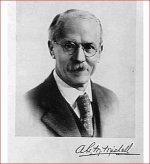I am well familiar with the Kingsbury tilting pad thrust bearings as used on large hydroelectric units. In the plant I retired from, the rotating assembly (generator rotor, main shaft, and turbine runner) weighed 800 tons. It rode on a tilting pad thrust bearing. These were Hitachi-designed and built pumped storage units, developing about 500,000 shaft horsepower at peak load. The thrust runner (rotating disc) was about 10 feet in diameter and there were 14 individual tilting pads. Each pad was a steel casting topped with babbitt. We used to send the thrust shoes to Kingsbury for rebabbitting, then hand scrape the pads to final flatness. Kingsbury taught us to use the Biax power scrapers, and about that same time, CNC machining centers were able to produce the required flatness. Since we use lift-oil pumps to force oil between the thrust shoes and thrust runner at startup and shutdown, Hitachi agreed that a hand scraped finish is no longer necessary.
We use oil at about 1500 psi to literally lift the thrust runner and rotating assembly a few thousandths of an inch off the shoes at startup and during shutdown. Once the unit is rolling at speed, an oil film is maintained between the thrust shoes and the runner without need of any pump. As a test, after a unit maintenance, we would hook a comealong to one spoke of the generator rotor with a dynamometer hooked into the rigging. We'd have a pool as to what force would be needed for breakaway. Usually 1200-1500 pounds, but once the breakaway occurred, a couple of mechanics could push on the rotor spokes and keep the unit rotating.
Kingsbury claimed to have been inspired to invent the tilting pad thrust bearing by seeing a full moon and the movement of the planets one clear night. At the time, a hydroelectric plant (Conowingo, in PA, I think) was bedevilled with thrust bearing issues, having tried rolling-element thrust bearings. Kingsbury, a prolific inventr of stuff from can openers to the tilting pad bearing, came up with the idea of the tilting pad bearing standing outdoors and seeing the moon as inspiration.
We used to send our thrust shoes to Kingsbury for rebabbitting. As is shown in this youtube, Kingsbury painted the shoes with a chalk wash to keep certain areas from being tinned. Then, the shoes were immersed in a vat of molten pure tin. This tinned the shoes in the areas to be babbitted and preheated them. I saw the babbitting process many times, tried my hand at scraping (though I was management not supposed to handle the tools), and was involved in many routine maintenances and overhauls and repairs to the thrust bearings over the years.
The tilting pad thrust bearing is a remarkable invention, and for heavy thrust loads, it is unlikely to ever have a better replacement.
Aboard ships, the old thrust bearing was known as a horse-collar type bearing. A thrust block is still needed aboard a ship to transfer the thrust from the propellor to the hull. Whether that thrust block is a tilting pad type of bearing or horse-collar type of bearing, the purpose is the same. The old horse collar type bearings required a shaft section with multiple collars or discs forged and machined on it. A series of babbitted "U" shaped collars (hence the horse-collar name) were held in position on adjustable jacking screws to bear against the collars on the shaft. A set of collars for the "ahead" direction and the "astern" (backing) direction were needed. The heavier the thrust load, the more collars were needed. A tilting pad bearing for marine applications has tilting pads on either side of the thrust runner disc.
Some experimentation was done using a mixture of PTFE (Teflon) and brass shreds to replace the babbiting and eliminate the oil bath which babbitted thrust bearings run in. Supposedly, this was tried on large hydro units, and after initial success, in service failures and heavy repairs resulted. To my knowledge, nothing equalling babbitt has ever been found to work in tilting pad thrust bearings on large size units.
In the USA, we refer to a tilting pad thrust bearing as a Kingsbury bearing, but we knew of the Michell bearing. Either way, a great concept and a great bearing with which I am quite familiar. Thanks for posting this youtube !




